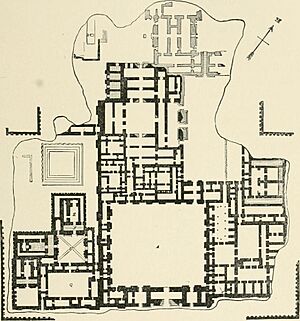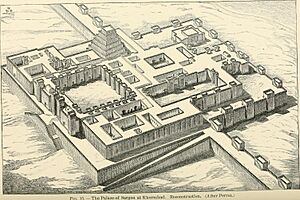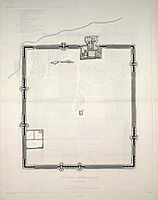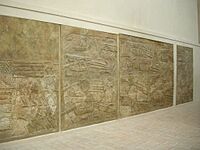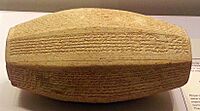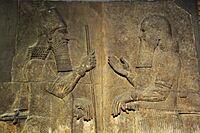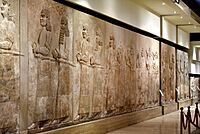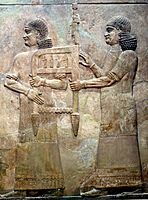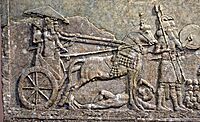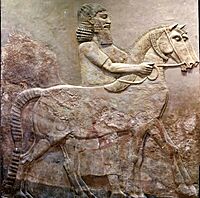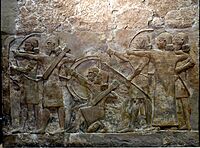Dur-Sharrukin facts for kids
|
ܕܘܪ ܫܪܘ ܘܟܢ
دور شروكين |
|

A human-headed winged bull known as a lamassu from Dur-Sharrukin. Neo-Assyrian Period, ca. 721–705 BC
|
|
| Alternative name | Khorsabad |
|---|---|
| Location | Khorsabad, Nineveh Governorate, Iraq |
| Region | Mesopotamia |
| Coordinates | 36°30′34″N 43°13′46″E / 36.50944°N 43.22944°E |
| Type | Settlement |
| Length | 1,760 m (5,770 ft) |
| Width | 1,635 m (5,364 ft) |
| Area | 2.88 km2 (1.11 sq mi) |
| History | |
| Founded | In the decade preceding 706 BC |
| Abandoned | Approximately 605 BC |
| Periods | Neo-Assyrian Empire |
| Cultures | Assyrian |
| Site notes | |
| Excavation dates | 1842–1844, 1852–1855 1928–1935, 1957 |
| Archaeologists | Paul-Émile Botta, Eugène Flandin, Victor Place, Edward Chiera, Gordon Loud, Hamilton Darby, Fuad Safar |
| Condition | Severely Damaged |
| Public access | Inaccessible |
Dur-Sharrukin (which means "Fortress of Sargon" in the ancient Assyrian language) is an old city that was once the capital of Assyria. Today, it is known as Khorsabad, a village in northern Iraq. It is about 15 kilometers northeast of Mosul. This amazing city was built very quickly, in just ten years, before 706 BC. However, after King Sargon died unexpectedly in a battle, his son moved the capital to Nineveh, which was about 20 kilometers south.
Contents
History of Dur-Sharrukin
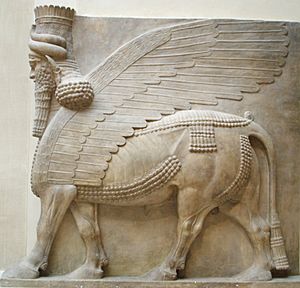
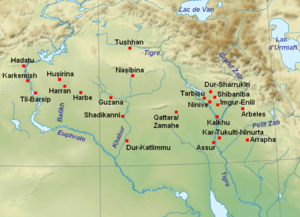
King Sargon II of Assyria ruled from 722 to 705 BC. He wanted to build a new capital city. To do this, he needed a lot of wood and other materials. He also needed skilled workers from far away places like Phoenicia. To get enough people to help build the city, Sargon even cancelled the debts of construction workers.
The land around the new city was used for farming. They planted olive trees to make more oil for Assyria. The city was mostly built by 706 BC, and the royal court moved there. But it was not completely finished. Sadly, King Sargon was killed in battle in 705 BC. His son, Sennacherib, became the new king. He decided to leave Dur-Sharrukin and move the capital to Nineveh. This meant Dur-Sharrukin was never fully completed. It was finally abandoned about a century later when the Assyrian Empire ended.
Damage to the Ancient City
In March 2015, there were reports that parts of Dur-Sharrukin were damaged and looted. This was done by a group that caused a lot of destruction to old sites. The Iraqi government started an investigation right away. Only one tunnel used for looting was found.
What Dur-Sharrukin Looked Like
The city of Dur-Sharrukin was shaped like a rectangle. It was about 1758 meters long and 1635 meters wide. The whole city covered an area of nearly 3 square kilometers. The city walls were very strong and had 157 towers to protect them. There were seven gates to enter the city from different directions.
Inside the city, there was a special walled area for temples and the royal palace. The main temples were for the gods Nabu, Shamash, and Sin. Smaller shrines were for Adad, Ningal, and Ninurta. There was also a large temple tower called a ziggurat. This ziggurat was special because it had a spiral ramp instead of stairs.
The king's palace was on the northern wall of the city. At the palace entrance, there was a ramp and a huge doorway. Giant statues of human-headed winged bulls, called lamassu, stood at the entrance. These statues weighed up to 40 tons! The palace walls were decorated with amazing sculptures and carvings.
In the southwest part of the city, there was another smaller fortress. This was used to control any problems inside the city or protect against attacks. The city also had a royal hunting park and a beautiful garden. This garden had many different plants and fruit trees from other lands. This showed how powerful the Assyrian kings were.
Discovering the Ancient City
Dur-Sharrukin was left empty a long time ago. So, it wasn't as well-known as some other ancient Assyrian sites. However, people in the Middle Ages knew about the mound where the city once stood. A geographer named Yaqut Al-Hamawi even wrote that the site was called Saraoun or Saraghoun. This shows that the original Assyrian name was not completely forgotten. He also said that treasures were found there long ago.
Early Digs
In the mid-1800s, European archaeologists started exploring ancient sites in northern Iraq. In 1843, the French Consul General in Mosul, Paul-Émile Botta, was digging at another site without much luck. Then, a local villager from Khorsabad told him about sculptures found in his village. Botta sent some workers to check it out. They found a wall made of carved stone slabs.
Botta quickly went to Khorsabad. He found a chamber connected to others, all covered with carvings showing battles and sieges. It was an amazing discovery! This was the start of serious archaeological work in ancient Mesopotamia. The ruins at Khorsabad were close to the surface, so Botta and his team quickly found the ancient palace. They uncovered many reliefs and sculptures.
However, many of these early finds were damaged when they were exposed to the air. Botta also had other duties and faced problems with local authorities. Eventually, he got more money and an artist, Eugène Flandin, from France. He even had to buy the village of Khorsabad and move it to continue digging! Botta thought he had found the famous city of Nineveh, but later digs proved him wrong. By 1847, the first major Assyrian finds from Dur-Sharrukin arrived in Paris, France. This made people in Europe very interested in this ancient civilization.
Lost Treasures: The Qurnah Disaster
In 1852, another French consul, Victor Place, continued the excavations. By 1855, many more ancient objects were ready to be sent to Paris. A large cargo ship and four rafts were used to carry them. But there were so many items!
The journey down the Tigris river was dangerous. Local groups often attacked ships. The convoy was stopped several times, and the crew had to give up money and supplies to pass. When the convoy reached Al-Qurnah, it was attacked by pirates. The main cargo ship sank, and the rafts were forced ashore. Almost all the treasures were lost. Only 28 out of over 200 crates made it to the Louvre Museum in Paris. Later attempts to find the lost artifacts have mostly failed.
More Recent Digs
American archaeologists from the Oriental Institute in Chicago dug at Khorsabad between 1928 and 1935. Edward Chiera led the first season. They found a huge bull statue, weighing about 40 tons, outside the throne room. It was broken into three pieces, and the main body alone weighed 20 tons. This huge piece was shipped all the way to Chicago!
Later seasons were led by Gordon Loud and Hamilton Darby. They explored one of the city gates and continued working at the palace and its temple complex. Since Dur-Sharrukin was abandoned in an orderly way, not many small objects were found. But the discoveries helped us learn a lot about Assyrian art and architecture.
In 1957, archaeologists from the Iraqi Department Antiquities, led by Fuad Safar, also dug at the site. They uncovered the temple of Sibitti.
Gallery
See also
- Cities of the ancient Near East
- Destruction of cultural heritage by ISIL
- Short chronology timeline
- List of megalithic sites



